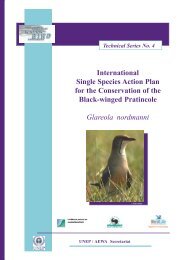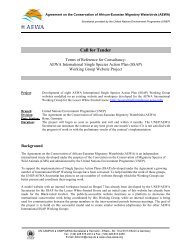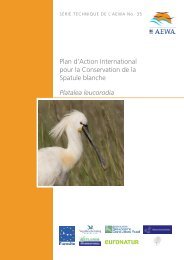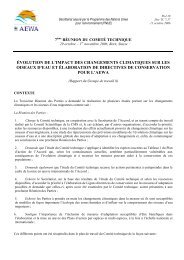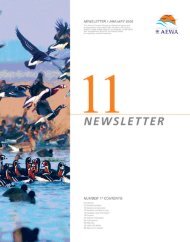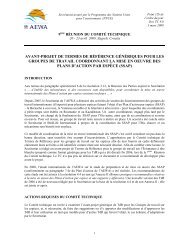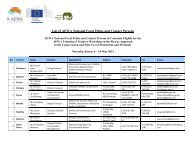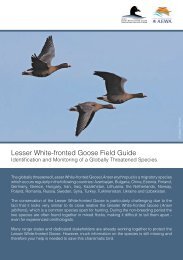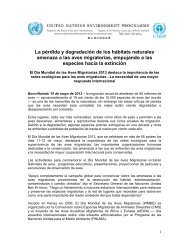International Single Species Action Plan for the ... - AEWA
International Single Species Action Plan for the ... - AEWA
International Single Species Action Plan for the ... - AEWA
You also want an ePaper? Increase the reach of your titles
YUMPU automatically turns print PDFs into web optimized ePapers that Google loves.
<strong>AEWA</strong> Technical Series No. 36 - Annexes<br />
sharp discontinuities in <strong>the</strong> allele frequencies and <strong>the</strong> estimated numbers of migrants that<br />
would result in <strong>the</strong> observed differences in allele frequencies indicate that <strong>the</strong>re is (or recently<br />
has been) enough movement of LWfG between eastern, central, and western parts of <strong>the</strong><br />
species range to have prevented evolutionary divergence and also to have prevented extreme<br />
loss of genetic diversity and accumulated inbreeding within any population segment. Thus,<br />
<strong>the</strong> populations do not appear to be genetically isolated to <strong>the</strong> extent that <strong>the</strong>y would be<br />
considered to be evolutionarily significant units or subspecies. The populations may have<br />
diverged partially with respect to traits adapted to local conditions, but <strong>the</strong> genetic mixing<br />
makes it unlikely that important adaptive differences have become “fixed” in (i.e., unique to)<br />
segments of <strong>the</strong> species range. Thus, dispersing or translocated individuals may have lower<br />
fitness because <strong>the</strong>y may more often have genotypes best suited <strong>for</strong> a different habitat, but<br />
each population probably still contains <strong>the</strong> range of genetic variability necessary to adapt to<br />
local conditions.<br />
The populations in Fennoscandia appear to have some reduction in genetic variation relative<br />
to more eastern populations, but <strong>the</strong>re is not yet evidence of problems arising from<br />
inbreeding, and such problems would not be likely to accumulate rapidly, given <strong>the</strong> evidence<br />
<strong>for</strong> some genetic connections to <strong>the</strong> larger populations to <strong>the</strong> east. Thus, it does not seem to<br />
me that it is necessary at this time to release individuals in Fennoscandia in order to “rescue”<br />
<strong>the</strong> population from a lack of genetic diversity.<br />
Although I do not think that <strong>the</strong> evidence suggests a current need to provide genetic rescue of<br />
<strong>the</strong> Fennoscandian population of LWfG, I do not agree with <strong>the</strong> suggestion that restoration of<br />
genetic variation should wait until <strong>the</strong> Fennoscandian population is extinct. Release of birds<br />
from o<strong>the</strong>r sources (whe<strong>the</strong>r from captive flocks of documented origin or translocations from<br />
o<strong>the</strong>r wild populations) may shift allele frequencies, but given <strong>the</strong> genetic closeness of <strong>the</strong><br />
LWfG populations in different regions it is hard to see how such releases could disrupt local<br />
adaptations to <strong>the</strong> extent that it would damage <strong>the</strong> prospects <strong>for</strong> <strong>the</strong> population. Instead, <strong>the</strong><br />
effects of such releases would be to restore genetic variants that could have been lost from <strong>the</strong><br />
small population and to reverse local inbreeding. Moreover, <strong>the</strong> extent of disruption of any<br />
local adaptations would be greatest if <strong>the</strong> remnant population is allowed to become nearly<br />
extinct be<strong>for</strong>e genetic management was resumed. Waiting until <strong>the</strong> local population is extinct<br />
would actually ensure that any local adaptations that did exist would be lost, instead of<br />
remaining within a more variable gene pool that could continue to adapt to local conditions.<br />
In contrast to <strong>the</strong> lack of evidence of notable genetic isolation of <strong>the</strong> Fennoscandia<br />
population, <strong>the</strong> extent of divergence of frequencies of genetic alleles does indicate that interpopulational<br />
dispersal is rare enough that <strong>the</strong> populations are demographically independent<br />
(or nearly so) and should be considered to be separate conservation “management units.”<br />
Thus, <strong>the</strong> movement of individuals into <strong>the</strong> Fennoscandia population is not sufficient to<br />
provide significant demographic rein<strong>for</strong>cement of a declining population; nor reestablishment<br />
of a population following regional extirpation. This is especially so if, as suggested from <strong>the</strong><br />
mtDNA patterns, most dispersal between regions is by males, with females being more<br />
philopatric. Dispersing males are as useful as are females <strong>for</strong> preventing genetic isolation and<br />
inbreeding, but <strong>the</strong>y have little demographic impact. The fact that <strong>the</strong> population in<br />
Fennoscandia continues to decline is evidence that natural dispersal among regions is not<br />
sufficient to support that population if it is not protected as an independently vulnerable<br />
management unit.<br />
There is a difference of opinion among <strong>the</strong> experts regarding whe<strong>the</strong>r <strong>the</strong> small and declining<br />
wild population in Fennoscandia is doomed to extinction if it is not supplemented. I have<br />
been involved with developing and assessing population viability models <strong>for</strong> a number of<br />
endangered species (but not <strong>for</strong> <strong>the</strong> LWfG). The probability of population recovery – after <strong>the</strong><br />
causes of decline are removed – is a function of <strong>the</strong> population size, with very small<br />
populations being more likely to experience inbreeding depression, locally imbalanced sex<br />
<strong>International</strong> <strong>Single</strong> <strong>Species</strong> <strong>Action</strong> <strong>Plan</strong> Lesser White-fronted Goose –Annexes<br />
L



